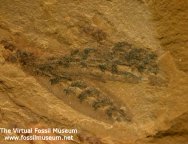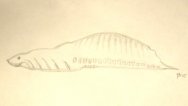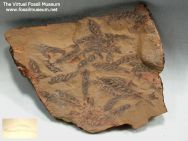Haikouella lanceolata
Geologic Time: Early Cambrian (~525 million years ago)
Size: 16-22 mm long on a 55 mm by 50 mm matrix
Fossil Site: Chengjiang Maotianshan Shales,: Quiongzhusi Section, Yu’anshan Member, Heilinpu Formation, Anning, Yunnan Province, China.
 This exceptional specimen is a multiple example of Haikouella lanceolata, thought by its describers to be the earliest craniate-like chordate. This fish-like animal has many similarities to the contemporaneous Yunnanozoon lividum, but differs in several aspects: it has a discernible heart, dorsal and ventral aorta, gill filaments (see the
This exceptional specimen is a multiple example of Haikouella lanceolata, thought by its describers to be the earliest craniate-like chordate. This fish-like animal has many similarities to the contemporaneous Yunnanozoon lividum, but differs in several aspects: it has a discernible heart, dorsal and ventral aorta, gill filaments (see the  closeup), and a neural chord. For all these reasons, it was identified by Chen, Huang, and Li in the seminal Nature paper (Nature 402, 518-522, 02 December 1999) as a chordate.
closeup), and a neural chord. For all these reasons, it was identified by Chen, Huang, and Li in the seminal Nature paper (Nature 402, 518-522, 02 December 1999) as a chordate.
The debate rages on, but whatever the outcome, this creature was much like the ancestor of all the vertebrates. It derives its generic name from its resemblance to the modern day lancet Amphioxus.
Also see: Chengjiang Biota, Chengjiang Fossils, Cambrian Explosion
RGP111017


